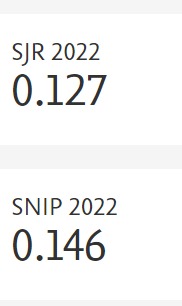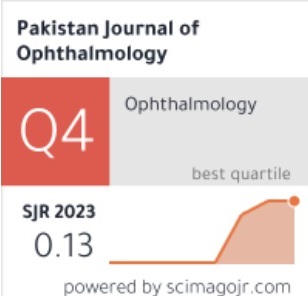Efficiency of Moria One-Use Plus Sub-Bowman’s Keratomileusis Head in Achieving Predicted Corneal Flap Thickness in Sub Bowmans Keratomileusis
Doi: 10.36351/pjo.v38i4.1405
DOI:
https://doi.org/10.36351/pjo.v38i4.1405Abstract
Purpose: To evaluate the difference between predicted and resultant corneal flap thickness in Sub-Bowmans Keratomileusis using Moria One-Use Plus sub-Bowman’s keratomileusis head.
Study Design: Interventional case series.
Place and Duration of Study: Liaquat National Hospital, Karachi, from April 2019 to September 2019.
Methods: Total 55 patients of either gender with age 20 to 45 years undergoing Sub-bowmans Keratomileusis (SBK) were included. Frequencies and percentages were computed for qualitative variables. Quantitative variables were presented as mean ± standard deviation. Student t-test, pair t test and ANOVA were used to compare the mean of resultant and predicted corneal flap thickness. Effect modifiers were controlled through stratification. Post stratification student t-test was again used to compare the mean of resultant and predicted corneal flap thickness. P-value ≤ 0.05 was considered significant.
Results: The mean age was 26.83 ± 4.38. There was an insignificant differences in preoperative, intraoperative and corneal flap thickness of both eye with respect to gender (P > 0.05). There was insignificant mean difference in preoperative and intraoperative corneal thickness (P > 0.05) of both eye with respect to age group but significant mean difference in resultant flap corneal thickness seen with both age group (P < 0.05). Significant difference was found in the flap thickness between the right and left eyes. The difference in the predicted and resultant flap thickness was statistically significant for right eye and insignificant for the left eye.
Conclusion: With Moria microkeratome, accuracy of the flap can be predicted in SBK. It is a safe and effective method to achieve the desired results.

Downloads
Published
How to Cite
Issue
Section
License
Copyright (c) 2022 dr munira shakir, DR SAHIRA WASIM, Dr Ronak afza memon, dr shakir zafar

This work is licensed under a Creative Commons Attribution-NonCommercial 4.0 International License.






